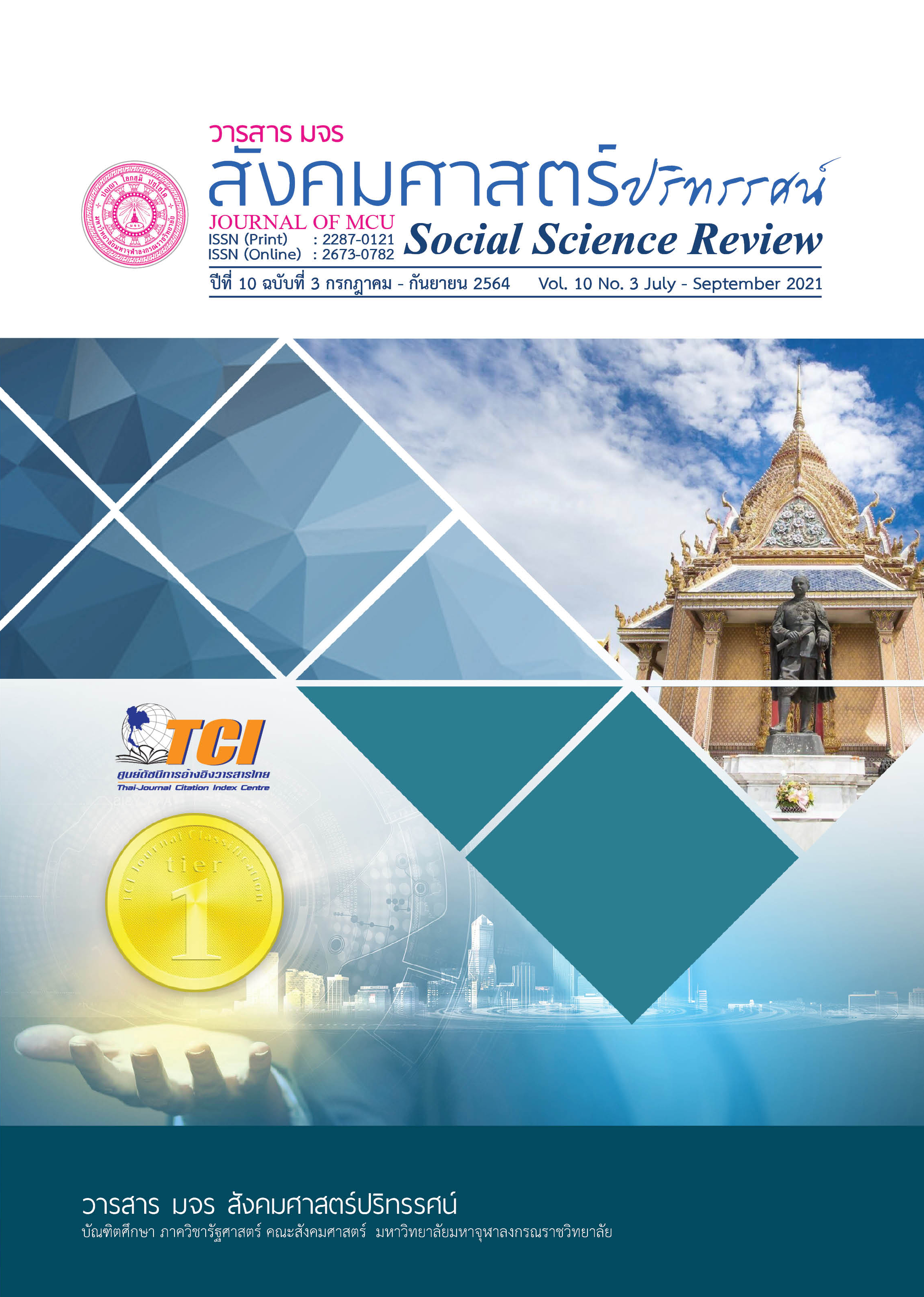Covid-2019: เสียงเพรียกจากลมหายใจแห่งธรรม
คำสำคัญ:
การเรียกร้อง, ลมหายใจ, อานาปานสติบทคัดย่อ
คงปฏิเสธไม่ได้ว่า โรคระบาด Covid-2019 สามารถติดต่อกันได้ทางการไอ การจาม หรือการพูดทำให้การแพทย์จึงออกประกาศให้ประชาชนตื่นตัวด้วยการใส่แมสปิดปากและปิดจมูกที่ไม่ให้เชื้อเข้าไปสู่ร่างกาย ซึ่งการไอ การจาม หรือการพูดจำเป็นต้องใช้ลมเป็นแรงขับส่งผ่านอวัยวะต่างๆ ทั้งหายใจและการพูดออกไม่ว่าจะเป็นทางปากหรือทางจมูกก็ตามหากไม่มีเครื่องป้องกันหรือเกิดความประมาทการ์ดตกก็สามารถรับเชื้อไวรัสได้ ทางพระพุทธศาสนาได้ให้ความสำคัญและได้กำหนดให้ชาวพุทธดูลมหายใจเข้าและลมหายใจออกที่เรียกว่า อานาปานสติ ที่เป็นได้ทั้งสมถกรรมฐานและวิปัสสนากรรมฐาน อันเป็นเครื่องป้องกันกิเลสตัณหาที่จะเกิดขึ้น เพราะชาวพุทธเชื่อว่า กิเลสที่ชั่วเมื่อมีอยู่ในผู้ใด ผู้นั้นย่อมรักษาให้หายขาดยาก แต่เชื้อไวรัสเมื่อเข้าสู่ร่างกายแล้ว ย่อมรักษาให้หายได้ พระพุทธองค์จึงทรงตักเตือน พร่ำสอน แนะนำให้ชาวพุทธกำหนดลมหายใจเข้า-ออก พิจารณาลมหายใจให้ดี และยกระดับการลด ละ เลิกความชั่วทั้งปวงจนกลายเป็นอุปนิสัยที่สามารถกำจัดกิเลสให้หมดไปได้นั่นก็เป็นลมหายใจอันเป็นเสียงเรียกหาตามธรรมชาติที่มนุษย์ควรจะดำเนินกิจกรรมให้ถูกต้อง ช่วยลดผลกระทบอันเลวร้ายไปสู่ผู้อื่นอย่างหมดจดด้วยอำนาจแห่งธรรม
เอกสารอ้างอิง
กรมควบคุมโรค กระทรวงสาธารณสุข. (2564). ไวรัสโคโรนาสายพันธุ์ใหม่ 2019 คือ?. สืบค้น 7 พฤษภาคม 2564, จาก https://ddc.moph.go.th/viralpneumonia/faq_more.php
ธัชกร โบว์แดง และคณะ. (2558). การฝึกสมาธิแบบอานาปานสติที่มีผลต่อความเครียดในการทำ งานของพนักงานบัญชี. วารสารวิชาการศิลปะศาสตร์ประยุกต์, 8(2), 91.
ธานี กล่อมใจและคณะ. (2563). ความรู้และพฤติกรรมของประชาชนเรื่องการป้องกันตนเองจากการติดเชื้อไวรัสโคโรนา สายพันธุ์ใหม่ 2019. วารสารการพยาบาล การสาธารณสุขและการศึกษา, 21(2), 32.
พระพรหมคุณาภรณ์ (ป.อ. ปยุตฺโต). (2543). พุทธธรรม (พิมพ์ครั้งที่ 9), กรุงเทพฯ: โรงพิมพ์มหาจุฬาลงกรณราชวิทยาลัย.
พระพุทธโกศาจารย์ (พุทธทาสภิกขุ). (2552). คู่มืออานาปานสติภาวนา อย่างสมบูรณ์แบบ. กรุงเทพฯ: สำนักพิมพ์สุขภาพใจ.
ภาควิชาจุลชีววิทยา คณะแพทยศาสตร์ศิริราชพยาบาล. (มปป). ไวรัสโคโรน่าสายพันธุ์ใหม่ 2019. กรุงเทพฯ: มหาวิทยาลัยมหิดล.
มหาจุฬาลงกรณราชวิทยาลัย. (2539). พระไตรปิฎกภาษาไทย ฉบับมหาจุฬาลงกรณราชวิทยาลัย. กรุงเทพฯ: โรงพิมพ์มหาจุฬาลงกรณราชวิทยาลัย, 2539.
มาลินี จิตตกานต์พิชย์. (2563). การตรวจวินิจฉัยโรคติดเชื้อไวรัสโคโรนา 2019. กรุงเทพฯ: กรมวิทยาศาสตร์การแพทย์.
วรรษมน จันทรเบญจกุล. (2563). การป้องกันการติดเชื้อไวรัสโคโรนา 2019. กรุงเทพฯ: ศูนย์โรคอุบัติใหม่ด้านคลินิก โรงพยาบาลจุฬาลงกรณ์.
วรวุฒิ อินทนนท์. (2554). การเปรียบเทียบการเรียนรู้อย่างมีความสุขของนักศึกษาที่ได้รับการฝึกสมาธิแบบอานาปานสติ และนักศึกษาที่เรียนตามปกติของนักศึกษาชั้นปีที่ 1 คณะศิลปศาสตร์และวิทยาศาสตร์ มหาวิทยาลัยนครพนม. วารสารมหาวิทยาลัยนครพนม, 1(1), 21.
สำนักงานกองทุนสนับสนุนการสร้างเสริมสุขภาพ. (2563). สู้ ! โควิด-19 ไปด้วยกันคู่มือดูแลตัวเองสำหรับประชาชน. กรุงเทพฯ: สำนักงานกองทุนสนับสนุนการสร้างเสริมสุขภาพ.
สุธาศินี เวชพราหมณ์และคณะ. (2555). ผลของการฝึกสมาธิแบบอานาปานสติและการจินตภาพที่มีผลต่อความสามารถในการยิงประตูโทษบาสเกตบอล. วารสารวิทยาศาสตร์การกีฬาและสุขภาพ, 13(3), 21.
สุรัยยา หมานมานะและคณะ. (2563). โรคติดเชื้อไวรัสโคโรนา 2019 (COVID-19). วารสารสถาบันบำราศนราดูร, 14(2), 124.
ดาวน์โหลด
เผยแพร่แล้ว
รูปแบบการอ้างอิง
ฉบับ
ประเภทบทความ
สัญญาอนุญาต
ลิขสิทธิ์ (c) 2021 วารสาร มจร สังคมศาสตร์ปริทรรศน์

อนุญาตภายใต้เงื่อนไข Creative Commons Attribution-NonCommercial-NoDerivatives 4.0 International License.
เพื่อให้เป็นไปตามกฎหมายลิขสิทธิ์ ผู้นิพนธ์ทุกท่านต้องลงลายมือชื่อในแบบฟอร์มใบมอบลิขสิทธิ์บทความให้แก่วารสารฯ พร้อมกับบทความต้นฉบับที่ได้แก้ไขครั้งสุดท้าย นอกจากนี้ ผู้นิพนธ์ทุกท่านต้องยืนยันว่าบทความต้นฉบับที่ส่งมาตีพิมพ์นั้น ได้ส่งมาตีพิมพ์เฉพาะในวารสาร มจร สังคมศาสตร์ปริทรรศน์ เพียงแห่งเดียวเท่านั้น หากมีการใช้ภาพหรือตารางหรือเนื้อหาอื่นๆ ของผู้นิพนธ์อื่นที่ปรากฏในสิ่งตีพิมพ์อื่นมาแล้ว ผู้นิพนธ์ต้องขออนุญาตเจ้าของลิขสิทธิ์ก่อน พร้อมทั้งแสดงหนังสือที่ได้รับการยินยอมต่อบรรณาธิการ ก่อนที่บทความจะได้รับการตีพิมพ์ หากไม่เป็นไปตามข้อกำหนดเบื้องต้น ทางวารสารจะถอดบทความของท่านออกโดยไม่มีข้อยกเว้นใดๆ ทั้งสิ้น





